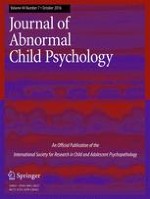11-01-2016
Academic and Social Functioning Associated with Attention-Deficit/Hyperactivity Disorder: Latent Class Analyses of Trajectories from Kindergarten to Fifth Grade
Gepubliceerd in: Research on Child and Adolescent Psychopathology | Uitgave 7/2016
Log in om toegang te krijgenAbstract
Children with attention-deficit/hyperactivity disorder (ADHD) are known to exhibit significantly lower academic and social functioning than other children. Yet the field currently lacks knowledge about specific impairment trajectories experienced by children with ADHD, which may constrain early screening and intervention effectiveness. Data were analyzed from a nationally representative U.S. cohort in the Early Childhood Longitudinal Study, Kindergarten Class of 1998–1999 (ECLS-K) for 590 children (72.7 % male) whose parents reported a formal diagnosis of ADHD. Children’s math, reading, and interpersonal skills were assessed at 5 time points between kindergarten and fifth grade. Growth mixture model analyses indicated 4 latent trajectory classes for reading, 8 classes for math, and 4 classes for interpersonal skills. Membership in reading and math trajectory classes was strongly related; overlaps with interpersonal skills classes were weaker. Trajectory class membership was correlated with demographic characteristics and behavioral functioning. Children with ADHD display substantial heterogeneity in their reading, math, and interpersonal growth trajectories, with some groups of children especially likely to display relatively severe levels of academic and social impairment over time. Early screening and intervention to address impairment, particularly reading difficulties, among kindergarten students with ADHD is warranted.
